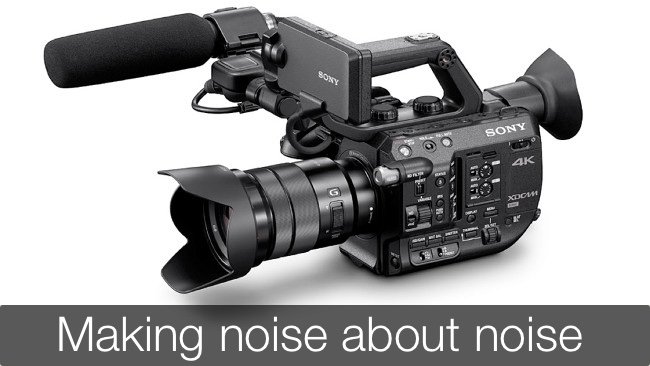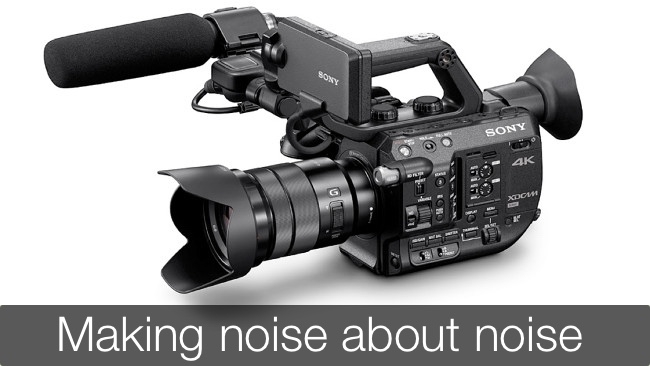

Phil Rhodes on the idea that Sony's new FS5 has poorer noise performance than the company's FS7.
So, there seems to have been a bit of shouting about the idea that Sony's FS5 has poorer noise performance than the FS7. Before we talk about this in any depth, it's worth pointing out that I haven't side-by-sided the cameras and while I'd be happy to do so, perhaps the more interesting comparison would be between FS7 and F5, which reportedly have much more similar internal layout – which is sort of the point at issue. Regardless, there's a couple of points that are worth making about these cameras in general and log shooting in particular, because a lot of people seem to be reaching unthinkingly for the “log” button without really understanding how it's intended to work.
Let's condense the idea to as few words as possible, since we've talked about how log works before. If we encode the brightness of a picture linearly, so that twice the light produces twice the numeric digital value, we end up using fully half of the available digital values (128 in an 8-bit system) to encode the brightest stop of information, because one stop represents a doubling of light intensity. This is not very helpful, because our eyes are not linear, and photographic stops actually look like a fairly even set of steps increasing in brightness. As a result, linear encoding results in way, way too many numeric values being used to encode the brightest parts of the image, while the shadows get terribly short-changed.
Log encoding aims to avoid this by – crudely put – boosting the brightness of dark parts of the image, so that they are encoded using more digital values. I put it that way because it emphasises why log encoding can make pictures look terribly noisy. Noise is often most prevalent in the darkest areas of the image, where the sensor is working hardest to detect a very small number of photons. If we boost that up so it's brighter, the issue will be much, much more visible if we connect that signal to a monitor. The point is, though, that the signal we're looking at is simply not designed to be viewed in that circumstance. We're looking at – for instance – an S-Log3 picture on a Rec. 709 display. We're viewing it wrong, just as if we'd projected a film negative and complained that the picture was negative, dark, and orangeish.
OK, coarse monitoring of log signals on 709 displays is done all the time, and as long as we bear in mind what we're looking at and use our experience, it's fine. The FS5 doesn't have the ability to shoot log while exporting a proper monitoring signal, and all but the most expensive displays lack the ability to correct the signal at their end. So, unless we're going to put a LUT box inbetween the camera and the display, it will look flat, desaturated and noisy. At this point, the SDI cable between camera and monitor is a bit bucket, throwing information at the display. It's up to the display, or a piece of intervening equipment, to properly make sense of it.
This will all be blindingly obvious to some people, but there's enough misunderstanding going on out there that I wouldn't be surprised if more than half the bitching that's going on about the FS5 is actually just provoked by a misunderstanding of log. They didn't build the camera to put out flat, grey, desaturated, noisy pictures because that's an aesthetic choice. You aren't monitoring it right, and while you may understand that, less technical people around you may not.
The other thing about the FS5 that may go some way to explaining the reported noise issues versus FS7 is that – gasp – FS5 is a lower-cost camera than FS7. It uses the same sensor, and thus the same sensor as F5, but the electronics are not identical. OK, on a modern, high-performance cinematography sensor like this, the information is almost certainly digitised on the sensor itself, and one might assume that the imaging performance is likely to be exactly the same. That's not quite true, though. Almost certainly, operations such as the recovery of an RGB image from the Bayer sensor data, as well as white balance and luminance encoding (be that 709, log, or whatever else) will take place in other electronics. “But it's digital,” I hear you cry. “It can't introduce noise.” Well, it certainly can, if one design works at a lower bit depth, or if, the demosaic algorithm were less advanced and required more work to recover normal colour performance. These two factors are examples, necessarily based on conjecture as nobody publishes information on the internal architecture of this sort of thing, but they demonstrate that different electronics certainly could affect noise performance.
We're perhaps moving some way beyond the very first generation of affordable 4K cameras, which I would hesitantly suggest includes the extant Blackmagic 4K stuff, JVC's early efforts and FS700. Those cameras were perhaps best considered as a route to really, seriously good HD pictures, and we await Blackmagic's 4.6K sensor with keen anticiaption. Perhaps the FS5 and FS7, and their use of the F5 imager, are an indication that the manufacturing processes for higher-end sensors are becoming more everyday. All of this is good. As a comparative matter, though, even if we all knew exactly how to shoot and monitor log correctly, which frankly we often don't, the FS5 is a lower-cost camera than the FS7. Nobody's positing really big problems, such as excessive fixed-pattern noise, that would indicate serious issues (competing cameras have not been so lucky). If FS5 had slightly poorer noise performance than FS7, a perfectly adequate answer from the manufacturer would be “Yes. And?”
Now, there's nothing wrong with Sony looking into the problem, but ultimately they could take this position and it would not be an excuse. It costs less. No excuse is required.
88
Tags: Production


Comments